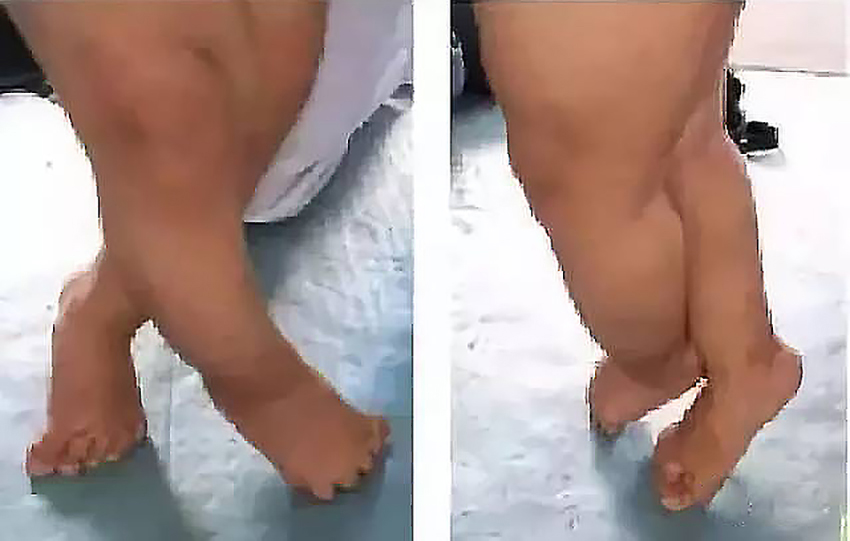News Center |

Spastic paraplegia is a kind of nervous system degenerative disease, clinical manifestation is gradual progress of the double lower limb spasm, powerless, walk the scissors gait, easy to fall down. If found not timely, it not only will lead to the paralyzed in bed and unable to walk in the late development, but will also pass on to the next generation.so it is necessary to do pathogenic gene identification decoding in early diagnosis. Take early detection and early treatment
Spasmodic paraplegia can be inherited, disease-causing genes are different, which resulting in different genetic patterns
Genetic studies have shown that spastic paraplegia is inherited by AD, AR, XLR and mitochondrial inheritance:
Autosomal dominant spastic paraplegia is the most common type and occurs in 75% to 80% of affected individuals:
SPG4 is the most common type of spASTIC paraplegia, and the main pathogenic gene is SPAST gene, accounting for about 40% of autosomal dominant spastic paraplegia.
SPG3A, ATL1, is the second most common autosomal dominant spastic paraplegia, accounting for about 10% to 15%. SPG3A is the main cause of early autosomal dominant spastic paraplegia (occurring in >75% of individuals in this category;
SPG30, KIF1A and SPG31, REEP1 are relatively common subtypes, accounting for about 5% of autosomal dominant spastic paraplegia, respectively.
Other types of adult-dominated autosomal dominant spastic paraplegia are relatively rare, with most accounting for 1% or less of autosomal dominant spastic paraplegia.

Genetic studies have shown that autosomal recessive spastic paraplegia has strong heterogeneity, and the number of newly discovered pathogenic genes is increasing continuously through gene decoding analysis. Many of the new genes are very rare ones confined to a single family or sporadic individual. About 25-30% of people with spastic paraplegia are autosomal recessive spastic paraplegia:
SPG5A, the pathogenic gene CYP7B1, accounted for 7.3% of all autosomal recessive spastic paraplegia, and 3% of sporadic simple spastic paraplegia;
SPG7, the pathogenic gene SPG7, accounts for about 5% of all autosomal recessive spastic paraplegia;
SPG11, the pathogenic gene SPG11, accounts for 3% to 5% of autosomal recessive spastic paraplegia, and 75% of patients with SPG11 have a thin or absent corpus callosum radiographic image.
X-linked spastic paraplegia and mitochondrial spastic paraplegia are the rarest genetic forms, accounting for less than 1% to 2% of all patients with spastic paraplegia.
In addition, there are several types of spasmodic paraplegia, such as ATL1, SPG7, and ALDH18A1, which can present in both autosomal recessive and autosomal dominant patterns.
How to diagnose spastic paraplegia?
Genetic studies have shown that spastic paraplegia can be divided into many types and the clinical symptoms are diverse. The same mutation can lead to different phenotypes among different patients, even among different patients in the same family. Some of the disease is more severe, and some of the disease is less severe, which is difficult to detect and often mistaken for normal behavior. Thus, the gold standard for diagnosing spastic paraplegia by identifying pathogenic genes, decoding genes, and testing can avoid other invasive and expensive tests, as well as avoiding delays.
"Identification of pathogenic genes of familial spastic paraplegia" adopts gene autonomous gene decoding technology, combines with international and domestic databases, and on the basis of high-throughput sequencing, accurately analyzes pathogenic genes leading to familial spastic paraplegia, so as to achieve accurate diagnosis and typing of familial spastic paraplegia. Higher detection rates, lower false-negatives, and greater reliability for gene correction in previously reported and studied causes of disease. Genetic counseling has better operability and clarity. Genetic testing, on the other hand, can only detect susceptibility and possibility, but cannot identify specific pathogenic genes.
Gene decoding experts suggest: when the occurrence of unexplained growth delay, muscle atrophy, body deformity and other abnormal circumstances should be carried out as soon as possible accurate and comprehensive pathogenic gene identification. One is clear diagnosis, avoid misdiagnosis, so as to have targeted control and treatment of the disease; The second is to understand the family genetic risk, to avoid the transmission of pathogenic genes in the family.
Copyright © 2015 USA-YOBAND. All Rights Reserved 沪ICP备09003269号